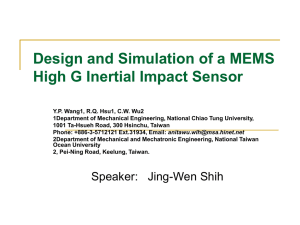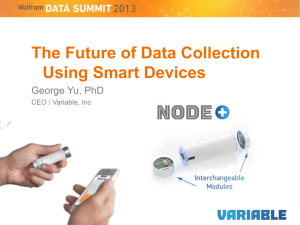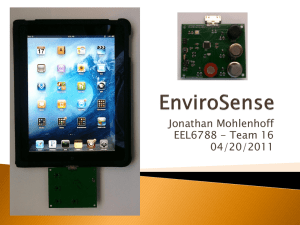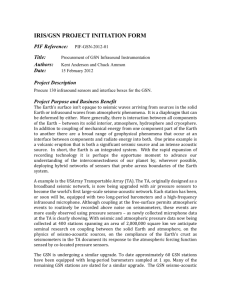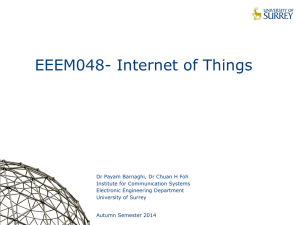gsn-nokia
advertisement
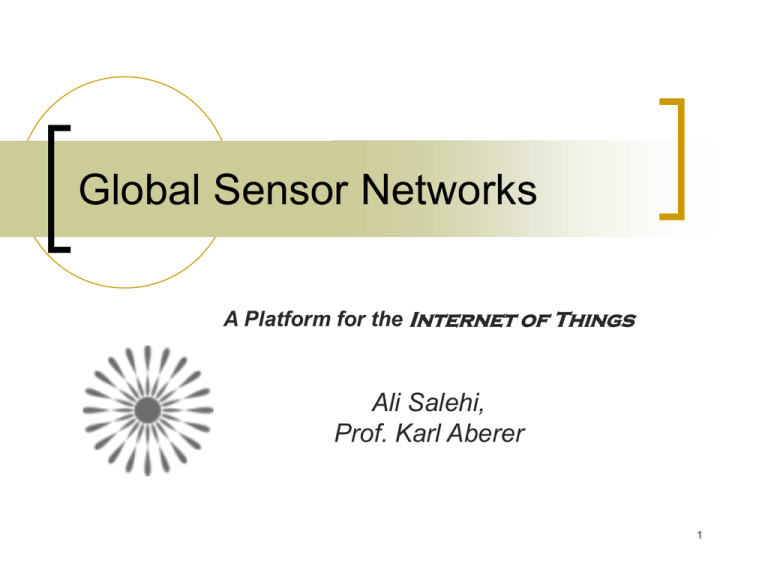
Global Sensor Networks A Platform for the Internet of Things Ali Salehi, Prof. Karl Aberer 1 What are Sensor Networks ? Sensors, and Actuators, Interconnected! Sensors Actuators 2 Properties of existing solutions Time consuming Hire Expert(s) Expensive To Modify People don't benefit from sensor networks. 3 Motivation, ? ? 4 Question : What is common ? 1. Stream of Data. 2. Structure can be defined. 3. Common Requirements. Virtual Sensor 5 WHAT DOES ALL THIS MEAN Internet of Things. 6 Solution, A Software : Hardware independent, any new hardware (sensors and actuators) should be integratable. Application independent. Light & Scalable (internet scale ; peer to peer) Modifications MUST be very cheap and simple. Modifications MUST be applied while system is running. Restarting the internet ?!!! 7 Design, Global Sensor Networks Common data processing, management and interfacing requirements, off the shelf. GSN = implementation of the virtual sensor concept and the all the listed requirements. Multi layered architecture to be deployable on resource constrained devices. 8 Simplicity, Simplicity, Simplicity (1) Email to MMS Service (swisscom) Application description A ) Select Image from Camera B ) Select Temperate from MoteA Select Camera.Image from A[window 1],B[window 10min] where avg(temperature) >30 9 Control Engineers Automatic Control Laboratory ,ETHZ Requirements: Simplicity, Unified Abstraction. Light & Temperature GSN Matlab Controller Electric blinds 10 Stream Services Develop sensor network applications : Virtual sensors. Might produce a stream of data (service). Buy a stream source : Hardware and/or Service (E.g., Lausanne temperature ). GSN Stream Sources Virtual Sensors 11 Simplicity, Simplicity, Simplicity (2) Self identifying devices (IEEE 1451). TEDS and Virtual TEDS. TEDS + Template Virtual Sensor = New Virtual Sensor Zero-programming deployment. 12 High Level View of The GSN * Uniform API for developing Sensor Network Applications. * Declarative Requirement Management. * Uniform API for exporting sensor data to the GSN. * Various protocols (interfaces) for accessing data. 13 Resource Discovery Addressing the virtual sensors : Static (e.g., socket address). Dynamic using a set of predicates : Using a Directory Service: <predicate key=“GPS.Latitude”>46.3423</predicate> <predicate key=“Type”>temperature</predicate> Distributed Directory Service (DDS)*: Based on P-Grid infrastructure. Each node acts as a peer in DDS. 14 * Not implemented yet. Resource Constrained Devices Resources are allocated on demand. Resource sharing as much as possible. 20 virtual sensors, 10% > CPU, 64MB RAM, 500 Mhz. Requirements (e.g., Nokia 770), 32-bit processor. 64 MB Memory and/or Swap Option. 25 MB Storage. 15 Wrappers, as of Today Bridge between the sensors/actuators and the GSN. Wrappers Actuators TinyOS 1.x SMS Service. TinyOS 2.x Email Service. Wise Nodes Pages Service. TI RFID Readers (20cm) Alien Tech. Readers (20m) Fax Service. Wired Cameras EPuck Robots. Networked Cameras Speaker Output (AT&T) Generic Bluetooth Protocol IEEE 1451 Compatibility Generic Serial Generic UDP 16 Outcome as of today. Successful Open Source Project. More than 20 sensors/actuators supported. 7 Releases of the engine (Stable). 30K visitors, 600 downloads. Users Community GNU GPL License 17 WHAT DOES ALL THIS MEAN GSN, Middleware for Internet of Things. Q/A 18




